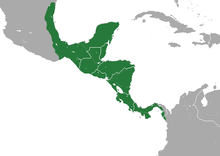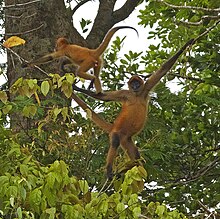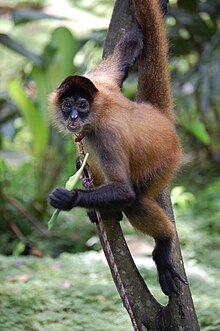Geoffroy spider monkey
| Geoffroy spider monkey | ||||||||||||
|---|---|---|---|---|---|---|---|---|---|---|---|---|

The nominate form of the Geoffroy spider monkey, Ateles geoffroyi geoffroyi |
||||||||||||
| Systematics | ||||||||||||
|
||||||||||||
| Scientific name | ||||||||||||
| Ateles geoffroyi | ||||||||||||
| Kuhl , 1820 |
The Geoffroy's spider monkey ( Ateles geoffroyi ) is a primate of the family of atelidae (Atelidae). It lives in Central America and its population is threatened. The name honors the French zoologist Étienne Geoffroy Saint-Hilaire .
features
Like all spider monkeys , Geoffroy's spider monkeys have a slender body with long, thin limbs and a long tail. The head-torso length of the males is 39 to 63 centimeters, that of the females 31 to 45 cm. The tail is longer than the body and is 70 to 86 centimeters long in the males and 64 to 75 cm long in the females. It is designed as a grasping tail , the rear part of the underside is hairless. At 7.4 to 9 kilograms, males are slightly heavier than females, which reach 6 to 8 kilograms. The color of the fur is extremely variable and can vary from reddish brown to dark brown to blackish, the belly and the inside of the limbs are lighter. The dark hands and feet are characteristic. The face is also dark. Long, forward-pointing hairs on the back of the neck form a kind of hood that ends in the form of a triangular comb over the eyebrows.
distribution and habitat
Geoffroy's spider monkeys live in Central America, making them the northernmost range of all spider monkeys. Their range extends from eastern Mexico to Panama . Their habitat is forests, they occur in different forest types, mainly in lowland rainforests, but also in deciduous forests, cloud forests and mangroves .
Way of life
These primates are diurnal tree dwellers that mostly live in the upper canopy. They are skilful and fast climbers, they move on all fours or by swinging swing, where they can hang on the tail as well as on individual limbs.
They live in territorial groups of 16 to over 40 animals and communicate with each other with loud, barking calls. The territories have a different size depending on the food supply, e.g. B. 42 ha in a group comprising 42 individuals in the Costa Rican National Park Santa Rosa or 960 ha in a group of 20 to 24 animals on Barro Colorado Island . In search of food, they roam their territory in small subgroups every day, covering distances between 460 and 2400 meters, the greatest distances being covered during the beginning of the dry season when the fruit supply is low. Within the hierarchical groups, the males dominate the females. Females move alone or form subgroups with their young or other semi-adult animals. Males form groups when they approach the territory boundary. Subgroups of males and females are mostly observed when the females are ready to receive. The population density can be relatively high and z. B. in the subspecies A. g. yucatanensis 24 to 90 individuals per km².
nutrition
Geoffroy's spider monkeys are herbivores that feed primarily on fruits. In addition, they eat leaves and other parts of plants. In a nine-month study, which was carried out in the Guatemalan Tikal National Park in Peten , the feeding habits of the Geoffroy spider monkey were examined in more detail. Fruits made up 84% of the food consumed there, 57% came from the breadnut tree ( Brosimum alicastrum ). In addition, the fruits of the pear apple tree ( Manilkara zapota ), a species of fig, were eaten by Cupania prisca , Spondias mombin and Dendropanax arboreus . Of the leaves recorded, 61% were young leaves and 68% of the eaten, mature leaves belonged to the breadnut tree. Animal food is rarely eaten (2% caterpillars and 1.4% beetles).
In the Costa Rican Santa Rosa National Park , the monkeys consumed 77.8% fruit, 9.8% flowers, 7.3% young leaves, 2.6% beetles and 1.3% other insects. Figs had a share of 29.2% and the sweet fruits of Muntingia calabura were eaten with pleasure. Only during the beginning of the dry season in January and February were mainly leaves eaten (70 to 80% of the food consumed). The proportion of fruit in the food consumed is between 14 and 100%, depending on the month.
Reproduction
Mating can occur all year round, but most births occur in the dry season (December to May). After a gestation period of around 230 days, the female usually gives birth to a single young. This is initially black in color, but the adult color appears within the first five months. The young are weaned at the earliest after 24 months, but remain close to the mother until a new young is born. The interval between two births is usually 32 to 35 months. Geoffroy's spider monkeys reach sexual maturity at four to five years of age and the females usually have their first young at the age of seven. The monkeys can live up to 27 years.
Systematics
The Geoffroy spider monkey was described by the German naturalist and zoologist Heinrich Kuhl in 1820 . It is one of seven species of the spider monkey genus ( Ateles ). Several subspecies have been described, some of which only occur in tiny populations of a few hundred animals. The subspecies are not well delimited from one another and require revision.
The subspecies are arranged here according to their distribution from northwest to southeast.
- Ateles geoffroyi vellerosus has a large distribution area that extends from eastern Mexico (east from San Luis Potosí , Veracruz , Tabasco , east from Oaxaca and Chiapas ) through Guatemala to El Salvador and Honduras. With the exception of a light band in the lumbar region, the subspecies is black to dark brown in color on the back. In stark contrast to this, the abdomen and the insides of the limbs are much lighter. Around the eyes, A. g. vellerosus, often flesh-colored, hairless skin.
- Ateles geoffroyi yucatanensis , lives in southeastern Mexico on the Yucatán peninsula and in adjacent areas in northeastern Guatemala and Belize and hybridizes with Ateles geoffroyi vellerosus in Campeche and Guatemala . The subspecies is smaller and slimmer than the other subspecies and colored black-brown on the head, shoulders and neck. The back and the outside of the limbs are lighter brown, the chest, abdomen and the inside of the limbs are silvery white.
- Ateles geoffroyi geoffroyi , the nominate form occurs in southern Nicaragua from San Juan de Nicaragua to the vicinity of Lake Managua and Lake Nicaragua near the Pacific coast and possibly also in northern Costa Rica. The back, upper arms and legs are silver-gray to brown-gray. The chest is colored similar to the back, the belly sometimes shimmers a little golden. Elbows, knees, lower legs, and forearms can be gray or blackish. Hands and feet are always black.
- Ateles geoffroyi frontatus , lives in the north and west of Nicaragua and in the north-west of Costa Rica. The subspecies is similar in color to the nominate form, but is darker.
- Ateles geoffroyi ornatus ( synonym : A. g. Panamensis ) also resembles the nominate form, is darker, the back is golden brown and the face, top of the head, the outside of the legs, forearms, hands and feet are black. The belly side is not much lighter than the back. The subspecies occurs in central and eastern Costa Rica as far as the Serranía de San Blas east of the Panama Canal and hybridizes with the brown-headed spider monkey ( A. fusciceps ) in the extreme east of the range .
- Ateles geoffroyi grisescens , is said to be found in southern Panama along the Pacific coast, but has never been seen in the wild. The type specimen was a spider monkey kept in captivity.
- Ateles geoffroyi azuerensis , is only known from mountain forests in the west of the Panamanian Azuero peninsula . The back is gray-brown and darker than the ventral side. As with A. g. ornatus , the outsides of the legs are black, but the top of the head and neck can be black or brown-black.
Danger
The Geoffroy spider monkey as a whole and the subspecies A. g. ornatus and A. g. yucatanensis are listed as Endangered by the IUCN , A. g. geoffroyi , A. g. azuerensis and A. g. vellerosus are critically endangered and A. g. frontatus is endangered (Vulnerable). The main reason for the endangerment is the loss of habitat due to deforestation. Because of this destruction, the total population has decreased by 50% over the past 45 years. Hunting plays a lesser role, with both meat and pet use being in the foreground. Large, undisturbed forests in which the Geoffroy spider monkey occurs still exist in Mexico, Guatemala and Belize in the Maya settlement area , in the east of Honduras and Nicaragua and along the Caribbean coast of Panama and in Darién .
There are various protected areas in their area of distribution. In Mexico, A. g. vellerosus protected in the Palenque National Park, A. g. yucatanensis occurs in the Cañón del Sumidero National Park . The only protected area for A. g. geoffroyi is the Arenal National Park in Costa Rica. A. g. frontatus lives in the national parks Barra Honda , Guanacaste and Rincón de la Vieja and A. g. ornatus occurs in the national parks Braulio Carrillo , Cahuita , Chirripó , Corcovado and Manuel Antonio . From A. g. azuerensis are said to exist only 145 individuals.
literature
- Thomas Geissmann : Comparative Primatology. Springer-Verlag, Berlin a. a. 2003, ISBN 3-540-43645-6 .
- Don E. Wilson, DeeAnn M. Reeder (Eds.): Mammal Species of the World. A taxonomic and geographic Reference. Johns Hopkins University Press, Baltimore MD 2005, ISBN 0-8018-8221-4 .
supporting documents
- ↑ a b c d e f g h Anthony B. Rylands, Russell A. Mittermeier , Fanny M. Cornejo, Thomas R. Defler, Kenneth E. Glander, William R. Konstant, Liliam P. Pinto & Maurício Talebi: Family Atelidae ( Howlers, Spider and Woolly Monkeys and Muriquis) , page 537 in Russell A. Mittermeier, Anthony B. Rylands & Don E. Wilson : Handbook of the Mammals of the World: Primates: 3rd ISBN 978-84-96553-89-7
- ^ IUCN entry on Ateles geoffroyi
- ^ IUCN entry on Ateles geoffroyi ornatus
- ^ IUCN entry on Ateles geoffroyi yucatanensis
- ^ IUCN entry on Ateles geoffroyi geoffroyi
- ^ IUCN entry on Ateles geoffroyi azuerensis
- ^ IUCN entry on Ateles geoffroyi vellerosus
- ^ IUCN entry on Ateles geoffroyi frontatus







